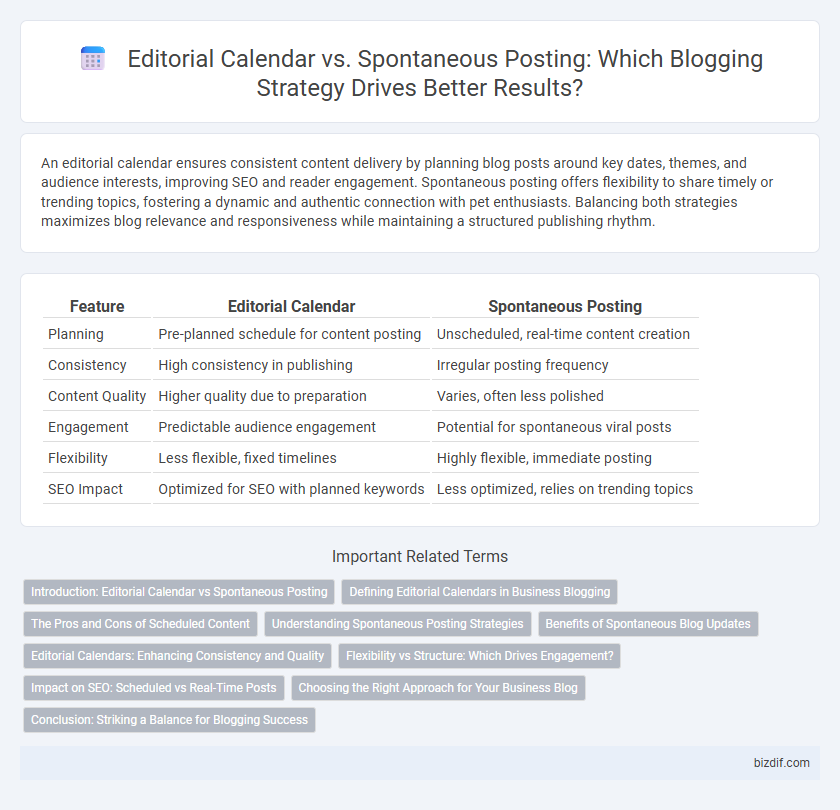An editorial calendar ensures consistent content delivery by planning blog posts around key dates, themes, and audience interests, improving SEO and reader engagement. Spontaneous posting offers flexibility to share timely or trending topics, fostering a dynamic and authentic connection with pet enthusiasts. Balancing both strategies maximizes blog relevance and responsiveness while maintaining a structured publishing rhythm.
Table of Comparison
| Feature | Editorial Calendar | Spontaneous Posting |
|---|---|---|
| Planning | Pre-planned schedule for content posting | Unscheduled, real-time content creation |
| Consistency | High consistency in publishing | Irregular posting frequency |
| Content Quality | Higher quality due to preparation | Varies, often less polished |
| Engagement | Predictable audience engagement | Potential for spontaneous viral posts |
| Flexibility | Less flexible, fixed timelines | Highly flexible, immediate posting |
| SEO Impact | Optimized for SEO with planned keywords | Less optimized, relies on trending topics |
Introduction: Editorial Calendar vs Spontaneous Posting
An editorial calendar provides a structured schedule for blog content, enhancing consistency and strategic planning to boost audience engagement and SEO performance. Spontaneous posting allows for real-time, flexible content creation, capturing trending topics and authentic voice but may lack continuity and long-term strategy. Balancing an editorial calendar with occasional spontaneous posts can optimize a blog's relevance and audience retention.
Defining Editorial Calendars in Business Blogging
Editorial calendars in business blogging serve as structured frameworks that schedule blog posts to maintain consistent publishing frequency and align content with marketing goals. These calendars optimize workflow by enabling teams to plan topics around seasonal trends, product launches, and audience engagement strategies. Utilizing editorial calendars enhances SEO performance by ensuring regular content updates and strategic keyword targeting.
The Pros and Cons of Scheduled Content
Scheduled content through an editorial calendar ensures consistent publishing, improves audience engagement, and streamlines workflow by organizing topics in advance. However, it may limit spontaneity and reduce responsiveness to trending topics or immediate audience interests, potentially impacting relevancy. Balancing planned posts with occasional spontaneous content can optimize reach and maintain authenticity in a blog's strategy.
Understanding Spontaneous Posting Strategies
Spontaneous posting strategies in blogging capitalize on real-time trends and authentic engagement to boost audience interaction and relevance. This approach requires agility and intuition, allowing bloggers to swiftly respond to unexpected events or ideas without the constraints of a fixed editorial calendar. Effective spontaneous posting integrates timely content creation with audience insights, maximizing impact through immediacy and originality.
Benefits of Spontaneous Blog Updates
Spontaneous blog updates enable real-time engagement with trending topics, boosting relevancy and audience interaction. This approach fosters authentic content creation, reflecting genuine brand voice and adaptability to sudden industry changes. Quick, spontaneous posts can increase SEO by capturing timely keywords and improving search engine visibility.
Editorial Calendars: Enhancing Consistency and Quality
Editorial calendars streamline content creation by scheduling posts in advance to maintain a consistent publishing rhythm, which enhances audience engagement and SEO performance. They enable efficient resource management by organizing topics, deadlines, and responsibilities, resulting in higher-quality blog entries aligned with strategic goals. Utilizing editorial calendars reduces last-minute pressure, allowing for thorough editing and refinement that improves overall content quality.
Flexibility vs Structure: Which Drives Engagement?
An editorial calendar offers a structured approach to content scheduling, ensuring consistency and strategic topic distribution that can boost long-term audience engagement. In contrast, spontaneous posting leverages real-time trends and timely reactions, providing flexibility that often sparks immediate interaction and relevance. Balancing both methods allows bloggers to optimize engagement by maintaining a reliable presence while adapting to dynamic audience interests.
Impact on SEO: Scheduled vs Real-Time Posts
An editorial calendar enhances SEO by ensuring consistent, keyword-rich content publication that aligns with search engine algorithms, boosting site authority and user engagement. Spontaneous posting can capture trending topics and real-time user interest, driving immediate traffic but lacks the systematic optimization key for long-term SEO benefits. Balancing scheduled posts with timely updates maximizes both steady growth and responsiveness to current search trends.
Choosing the Right Approach for Your Business Blog
An editorial calendar ensures consistent content delivery by scheduling posts around key dates and target audience interests, increasing SEO performance and reader engagement. Spontaneous posting allows flexibility to react to timely trends and authentic topics, fostering a dynamic connection with your audience. Balancing both strategies based on your business goals and resources optimizes blog visibility and relevance in competitive markets.
Conclusion: Striking a Balance for Blogging Success
Striking a balance between an editorial calendar and spontaneous posting maximizes blogging success by combining consistency with creative freedom. An editorial calendar ensures timely content delivery and audience engagement, while spontaneous posts capture trending topics and authentic moments. Integrating both strategies helps maintain relevance and adaptability in a competitive blogging landscape.
Editorial Calendar vs Spontaneous Posting Infographic

 bizdif.com
bizdif.com